
All About Morgue Coolers: Options, Features, and Buying Tips
Why Proper Morgue-Cooler Selection Matters for Funeral Professionals
A morgue-cooler is a specialized refrigeration unit designed to preserve human remains by maintaining precise temperatures between 36°F-39°F (2°C-5°C). These units slow decomposition, giving families time to plan services while ensuring dignified, respectful care.
Key Morgue-Cooler Types & Capacities:
- Walk-in coolers: 9-50 body capacity with cantilever racks
- Upright models: 2-6 bodies, space-efficient design
- Roll-in units: Mobile options with mortuary cot compatibility
- Body boxes: 1-6 capacity, plug-and-play installation
- Custom solutions: Custom to specific facility constraints
Essential Features:
- Temperature range: 36°F-39°F standard, -10°F to -50°F for long-term storage
- Self-contained units requiring no drainage
- Standard 110V electrical connection
- 15-year panel warranty, 5-year mechanical warranty
- NSF/OSHA compliance with safety release handles
As one funeral director noted: "It is literally a game changer in the funeral industry." Modern morgue-coolers offer American-made reliability with telescoping slide rails, digital temperature controls, and WiFi monitoring capabilities.
The challenge many funeral home directors face isn't just finding a morgue-cooler—it's finding the right one that fits their space, budget, and operational needs without the headache of delayed deliveries or poor support.
I'm Mortuary Cooler, a national-level morgue-cooler supplier with extensive experience helping funeral professionals select the most suitable refrigeration solutions for their facilities. My expertise spans everything from compact 2-body units to large walk-in morgue-cooler installations across diverse operational requirements.
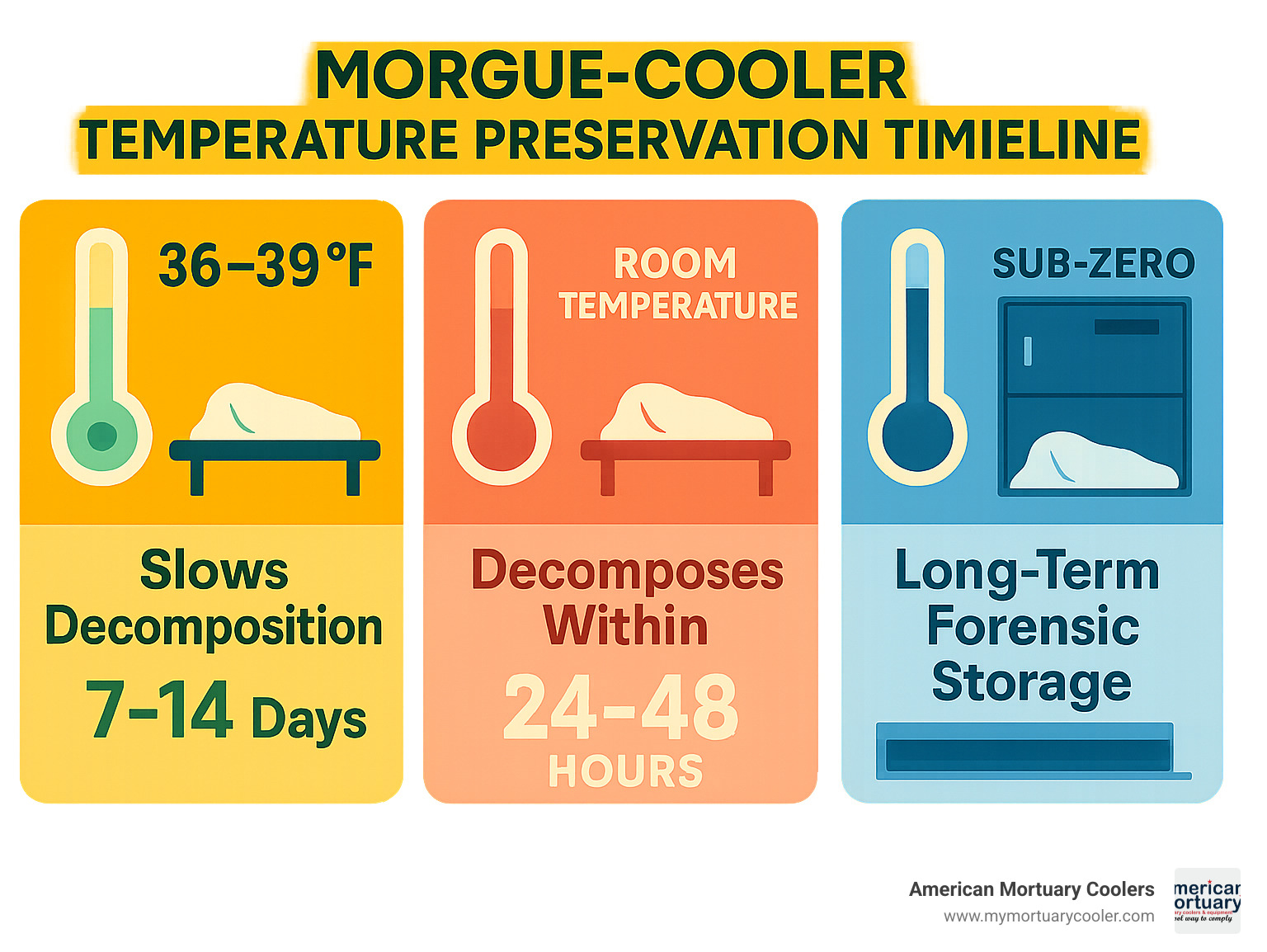
Simple guide to morgue-cooler:
Why This Guide Matters
The mortuary industry has seen growing demand for reliable refrigeration solutions. Walk-in mortuary coolers can store a minimum of nine bodies, with some custom walk-in units offering up to 50-body capacity with mortuary storage rack systems. Yet many funeral directors struggle with capacity planning, unsure whether they need a compact 2-body unit starting at approximately $6,095 or a larger 4-body model around $9,049.
We've seen facilities make costly mistakes—purchasing undersized units that can't handle peak demand, or oversized coolers that waste energy and space. This guide eliminates those buyer challenges by providing clear, actionable information based on real-world experience from our installations across Tennessee, Georgia, Illinois, and nationwide.
Understanding Morgue-Cooler Basics
When you're dealing with the sacred responsibility of caring for someone's loved one, precision matters. A morgue-cooler isn't just another refrigerator—it's a specialized piece of equipment that creates the perfect environment to preserve human remains with dignity and respect.
Most professional morgue coolers maintain temperatures between –2°C to 5°C (28°F to 41°F). That might seem like a narrow range, but it's precisely calibrated for optimal preservation. Modern microprocessor controllers keep temperature deviations to just ±1°C, ensuring consistent conditions around the clock.
The science behind preservation is actually quite straightforward. Bacterial growth that causes decomposition slows dramatically at these cold temperatures. While human remains might only last hours or days at room temperature, proper refrigeration extends this timeline to weeks—giving families the time they need for funeral planning without compromising the dignity of their loved one.
What sets quality morgue coolers apart is their airflow systems. Forced-air circulation prevents hot spots and ensures every corner maintains the same temperature. This isn't just about cooling—it's about creating uniform conditions that preserve remains consistently throughout the storage area.
All reputable units must meet strict NSF, OSHA, and EISA compliance standards. These aren't just bureaucratic requirements—they're safety measures that protect both the deceased and the professionals who care for them. Scientific research on cadaver preservation continues to refine these standards as our understanding improves.
What Is a Morgue-Cooler?
A morgue-cooler is purpose-built refrigeration designed specifically for storing and preserving human remains. You'll find these units in funeral homes, hospitals, medical examiner offices, and morgues—anywhere that requires respectful, professional care of the deceased.
The primary purpose goes far beyond simple cooling. These units maintain precise temperature and humidity while providing easy, dignified access for mortuary staff. Features like OSHA-compliant safety release handles ensure staff safety, while magnetic gaskets and specialized insulation maintain optimal internal conditions.
Unlike your typical commercial refrigerator, morgue coolers are built to handle the unique requirements of human remains storage. They're designed with wider doors, stronger shelving systems, and more precise controls—because this isn't about preserving food, it's about preserving someone's final moments with their loved one.
How Morgue Coolers Slow Decomposition
The refrigeration cycle in a morgue cooler works similarly to commercial units, but with medical-grade precision. Digital temperature controllers monitor conditions continuously, with audio-visual alarms alerting staff immediately if anything goes wrong.
Modern units use eco-friendly R-134 non-CFC refrigerants paired with finned-tube evaporators. This isn't just environmentally responsible—it's also more reliable and efficient than older systems.
Humidity control is equally critical. High-grade insulation between double walls minimizes thermal losses while maintaining optimal moisture levels. Too dry, and you risk desiccation. Too humid, and you create conditions for unwanted bacterial growth.
The most advanced units include glycol systems versus direct-expansion cooling. Glycol systems provide more even temperature distribution and better humidity control, though they require slightly more maintenance. Direct-expansion systems are simpler and more cost-effective for smaller facilities.
Some professional-grade morgue coolers even include data logging with computer connectivity—essential for regulatory compliance and quality assurance. When families trust you with their most precious moments, having detailed records of proper care isn't just good business—it's the right thing to do.
Types of Morgue Coolers & Capacity Planning
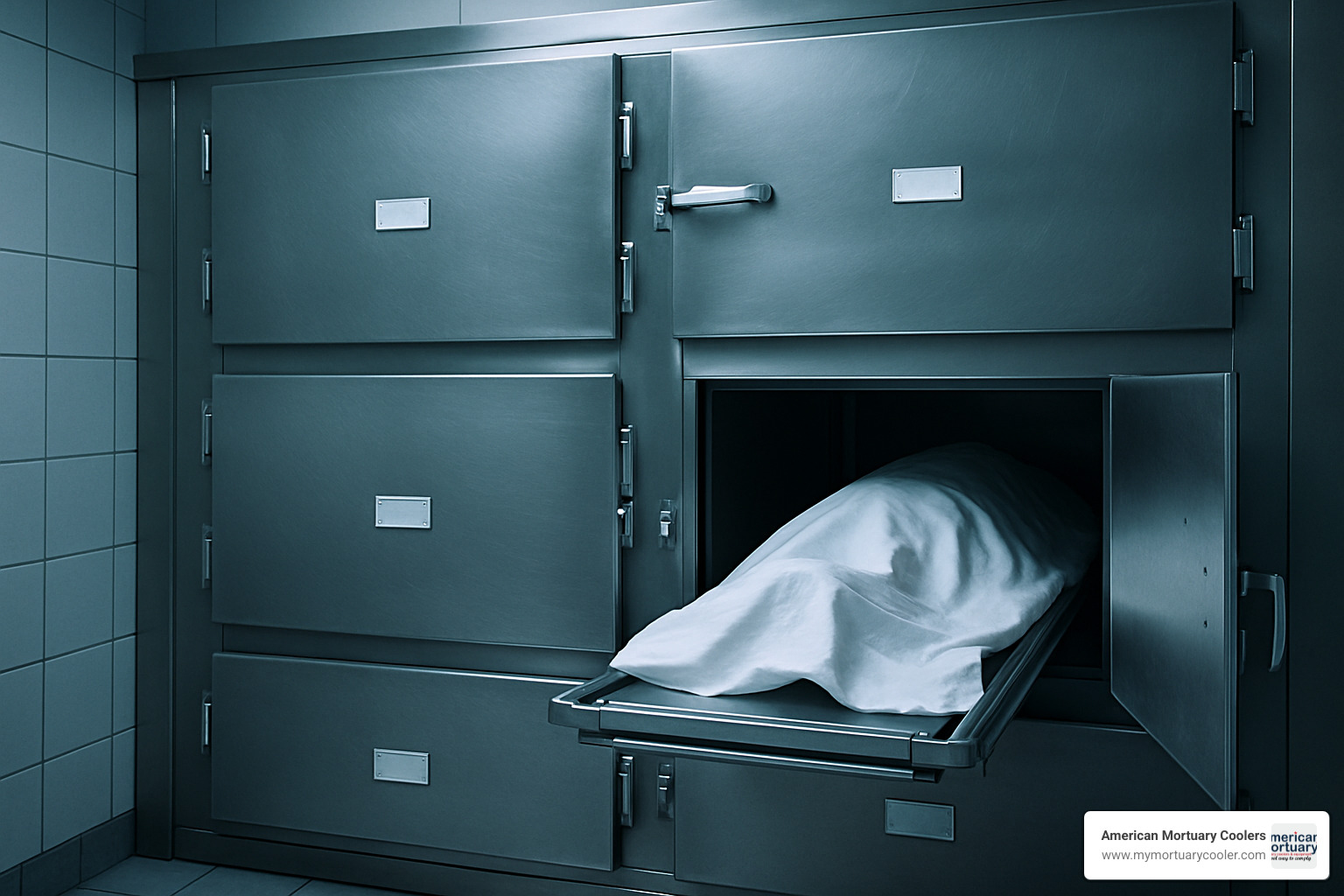
The morgue-cooler market offers diverse options to match facility needs and space constraints. Understanding capacity requirements is crucial—we've seen facilities struggle with inadequate storage during unexpected surges in cases, while others waste money on oversized units.
Here's a practical comparison of common morgue-cooler types:
| Type | Capacity | Space Required | Best For | Price Range |
|---|---|---|---|---|
| Body Boxes | 1-6 bodies | Minimal footprint | Small facilities, backup storage | $6,095-$15,975 |
| Upright Units | 2-6 bodies | Compact vertical | Rural hospitals, space-constrained | $7,611-$12,000 |
| Roll-in Coolers | 2-3 bodies | Medium footprint | Mobile needs, cot compatibility | $8,000-$14,000 |
| Walk-in Coolers | 9-50 bodies | Large dedicated room | High-volume facilities | $15,000-$75,000+ |
Walk-In Morgue-Cooler Solutions
Walk-in coolers provide the best solution for most high-volume cadaver storage needs. These units can accommodate anywhere from 9 to 50 bodies using cantilever storage rack systems or mortuary rack configurations. The modular prefabricated panel design allows for easy assembly, disassembly, relocation, and expansion as your facility grows.
A standard 8'×12' walk-in cooler can provide capacity for up to twenty-five people, making it ideal for large funeral homes or medical examiner facilities. These units feature 4-inch thick, high R-value insulated panels that meet EISA compliance requirements under the Federal Energy Independence & Security Act of 2007.
Key advantages include:
- Maximum storage efficiency per square foot
- Easy staff movement and body handling
- Customizable interior configurations
- Optional refrigeration redundancy for critical applications
- Professional cantilever storage systems that maximize vertical space
Upright & Roll-In Options
Upright coolers are perfect for rural morgues or hospital settings due to their economical footprint and space-saving design. These units typically store 2-6 bodies and are ideal when floor space is limited but ceiling height allows for vertical storage.
Roll-in coolers offer mobility advantages with built-in casters and compatibility with standard mortuary cots. Most self-contained upright mortuary coolers can be plugged into a standard 110V outlet and require no special electrical systems or drainage, increasing installation flexibility.
Popular configurations include:
- 2-body roll-in style: Compact units with telescoping slide rails
- 3-body upright: Standard width or extra-wide configurations
- 4-body upright: Available with or without insulated floors
- Side-load models: Easier access in tight spaces
Mobile, Modular & Emergency Units
Mobile morgue-coolers serve critical roles in disaster response and temporary storage needs. These trailer-mounted units can be quickly deployed to locations requiring emergency morgue capacity. Various manufacturers offer mobile units specifically designed for transportation and emergency scenarios.
For facilities needing temporary solutions, rental options are available for mortuary coolers and freezers to meet all temporary cold storage needs. This rental option proves invaluable during facility renovations, equipment failures, or unexpected capacity demands.
Modular designs offer particular advantages:
- Quick assembly—some turnkey systems can be set up in just two hours
- Easy relocation when facility needs change
- Expandable configurations as your business grows
- Cost-effective compared to permanent construction
Key Features, Components & Custom Options
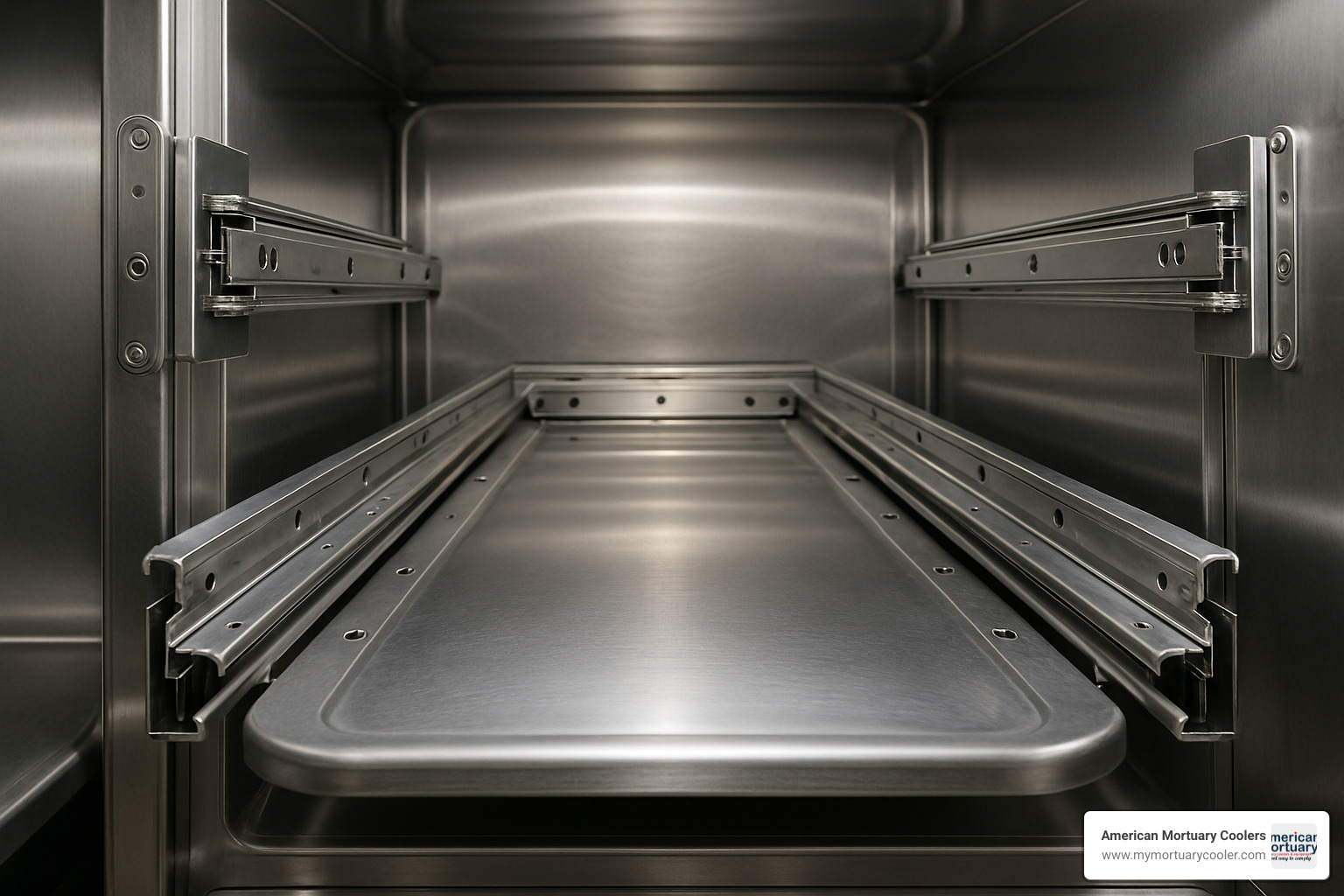
When you're investing in a morgue-cooler, you're not just buying a refrigerator—you're choosing a preservation system that needs to work flawlessly for years. The difference between a basic unit and a professional-grade morgue cooler lies in the details that matter most when you're caring for families during their most difficult times.
High-density polyurethane foam insulation provides the backbone of any quality morgue-cooler, delivering superior R-value performance that keeps temperatures stable while reducing energy costs. The interior surfaces matter just as much—stainless steel SS-304 grade resists corrosion and bacteria growth, while some units offer galvanized steel with specialized bacteria-resistant coatings as a cost-effective alternative.
UL-NSF approved doors with magnetic gaskets create airtight seals that maintain consistent temperatures. These doors feature self-actuating hinges that close automatically, preventing accidental temperature loss during busy periods. The heavy-duty chrome-plated hardware resists corrosion even in high-humidity environments.
Modern units include vapor-proof LED lighting with exterior switches and pilot lights, so staff can see clearly without compromising the unit's sealed environment. The telescoping slide rails shown in the image above make body handling significantly easier—a feature that reduces physical strain on mortuary staff while ensuring dignified care.
WiFi temperature monitoring has become increasingly popular, sending mobile app alerts if temperatures drift outside safe ranges. This technology prevents costly losses and ensures regulatory compliance, especially important for facilities that operate with limited overnight staffing.
Positive vs. Negative Temperature Morgue-Cooler Models
The temperature range you choose for your morgue-cooler depends entirely on how long you need to preserve remains and what type of facility you're operating.
Positive temperature models operating at 2-4°C (36-39°F) handle the vast majority of funeral home needs. These units provide optimal preservation for short to medium-term storage—typically days to weeks—which covers most funeral planning timelines. They consume significantly less energy than their negative temperature counterparts, keeping your operating costs manageable.
Negative temperature models running from -10°C to -50°C (-14°F to -58°F) serve specialized applications like forensic laboratories and medical research facilities. When bodies must be stored for months or years, these units become essential. However, the energy requirements increase substantially, making them cost-prohibitive for most standard funeral operations.
For most funeral homes, positive temperature morgue-coolers strike the perfect balance between preservation effectiveness and energy efficiency. The lower operating costs make them the practical choice for day-to-day operations.
Modular & Mobile Design Advantages
Panelized construction has revolutionized how morgue-coolers are installed and maintained. Instead of building permanent structures, modern units use precision-formed insulated panels that snap together like sophisticated building blocks. This approach offers flexibility that traditional built-in systems simply can't match.
When your facility needs change—and they inevitably do—you can reconfigure, expand, or even relocate your entire morgue-cooler system. We've seen funeral homes grow from small operations to major facilities, and their modular coolers grew right along with them.
Some budget-conscious facilities have acceptd CoolBot technology, which pairs a standard air conditioner with specialized controls to create effective walk-in coolers. A typical 8'×12' CoolBot system costs around $5,000—a fraction of traditional commercial refrigeration. More info about CoolBot solutions
The installation advantages are equally compelling. Reduced installation time means less disruption to your operations, while lower upfront costs preserve capital for other facility improvements. Perhaps most importantly, easier maintenance access to all components means faster repairs and lower service costs over the unit's lifetime.
When you're ready to expand or your facility relocates, modular morgue-coolers move with you—protecting your investment while adapting to your changing needs.
Buying, Installing & Maintaining a Morgue-Cooler
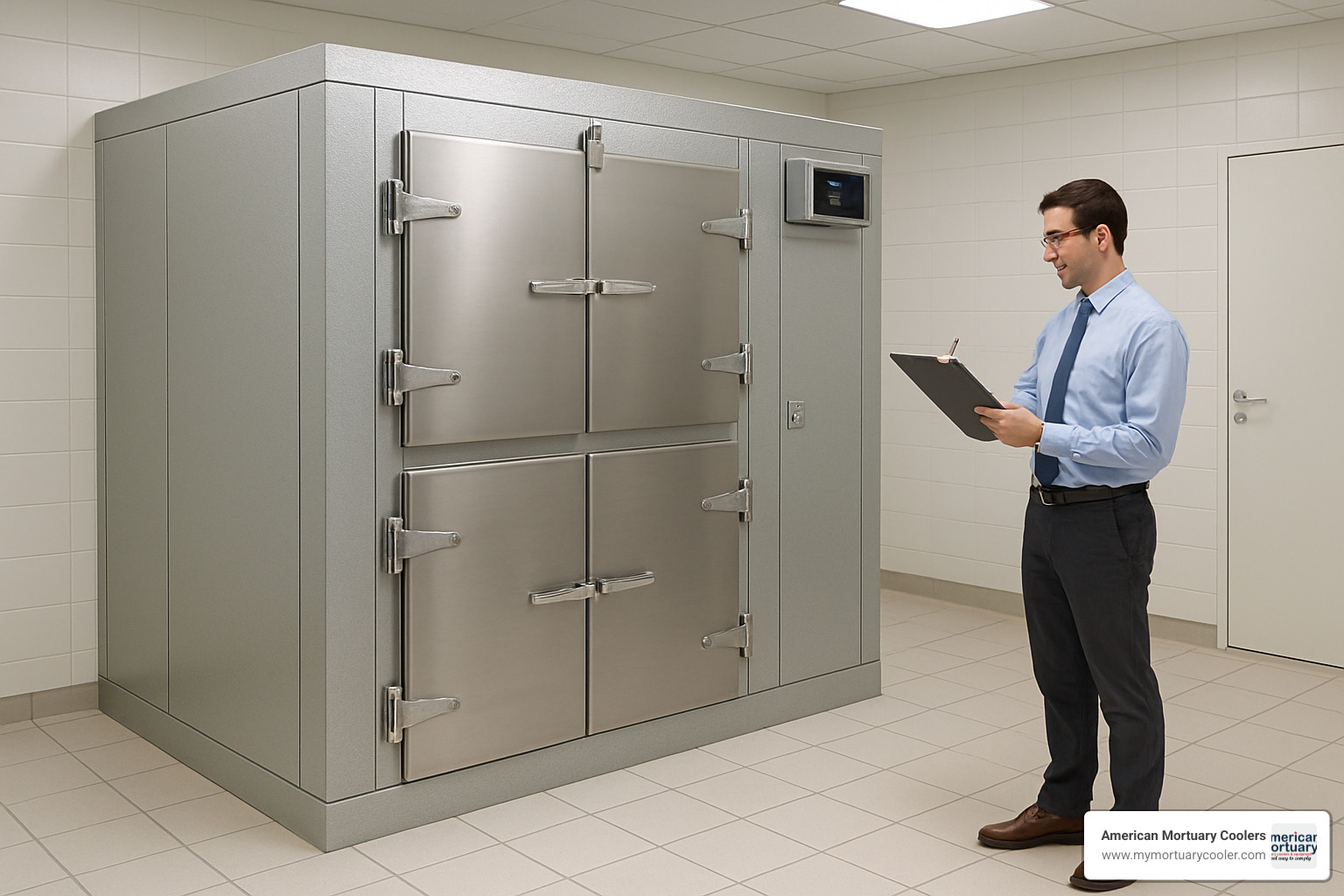
The good news about modern morgue-cooler systems? They're designed to make your life easier, not harder. Gone are the days of complex installations requiring specialized contractors and weeks of downtime.
Most self-contained upright mortuary coolers simply plug into a standard 110V outlet—no special electrical work, no drainage connections, no headaches. It's almost like setting up a large appliance, except this one happens to be engineered for the most important work you do.
When you invest in an American-made morgue-cooler, you're getting peace of mind built right in. The 15-year panel and door warranty paired with a 5-year mechanical parts warranty reflects what manufacturers know about their equipment's durability. These aren't optimistic promises—they're realistic expectations based on real-world performance.
The key to a smooth installation is proper planning. Site preparation doesn't have to be complicated, but it does need to be thorough. Energy audits during the planning phase help you understand the true cost of ownership, while utility rebates can offset initial investment costs for energy-efficient models.
Installation Checklist & Regulatory Must-Haves
Nobody enjoys dealing with regulations, but they exist for good reasons—mainly keeping your staff safe and your facility compliant. The installation checklist might seem long, but most reputable suppliers handle much of this for you.
OSHA safety requirements center around one critical feature: those safety release handles inside every door. If someone accidentally gets locked inside, they can get out safely. It sounds obvious, but it's literally a life-saving requirement that every unit must meet.
EISA 2007 compliance under the Federal Energy Independence & Security Act ensures your walk-in panels meet current energy efficiency standards. This isn't just regulatory box-checking—it directly impacts your monthly utility bills.
UL-NSF door certification guarantees that materials are appropriate for medical and mortuary applications. You're storing human remains, not produce, so the standards are understandably higher.
Local code permits vary by location, but most involve building permits for permanent installations and health department approvals for mortuary operations. Your supplier should guide you through the specific requirements in your area.
Maintenance, Monitoring & Energy Savings
Here's something that might surprise you: a well-maintained morgue-cooler can run reliably for decades. The secret isn't complicated—it's consistency.
Monthly maintenance takes maybe thirty minutes. Clean interior surfaces with approved sanitizers, check that door gaskets seal properly, and verify your temperature readings match your backup thermometer. Test those alarm systems too—they're only helpful if they actually work when needed.
Quarterly tasks dig a bit deeper. Those condensing unit coils need cleaning periodically, especially in dusty environments. Check refrigerant levels and lubricate door mechanisms. If you have telescoping slide rails, they'll appreciate the attention.
Annual professional inspections catch problems before they become emergencies. Gasket replacement, temperature controller calibration, and comprehensive system tune-ups extend equipment life significantly.
The real game-changer is WiFi monitoring technology. Modern systems send alerts directly to your phone for temperature deviations, power outages, or equipment issues. You'll know about problems before they become disasters, and the automated record-keeping satisfies regulatory requirements without extra paperwork.
Energy efficiency improvements pay for themselves over time. Eco-friendly refrigerants, high R-value insulation, and microprocessor controls minimize operating costs while maintaining precise temperature control. Some facilities see utility rebates that offset upgrade costs within the first few years.
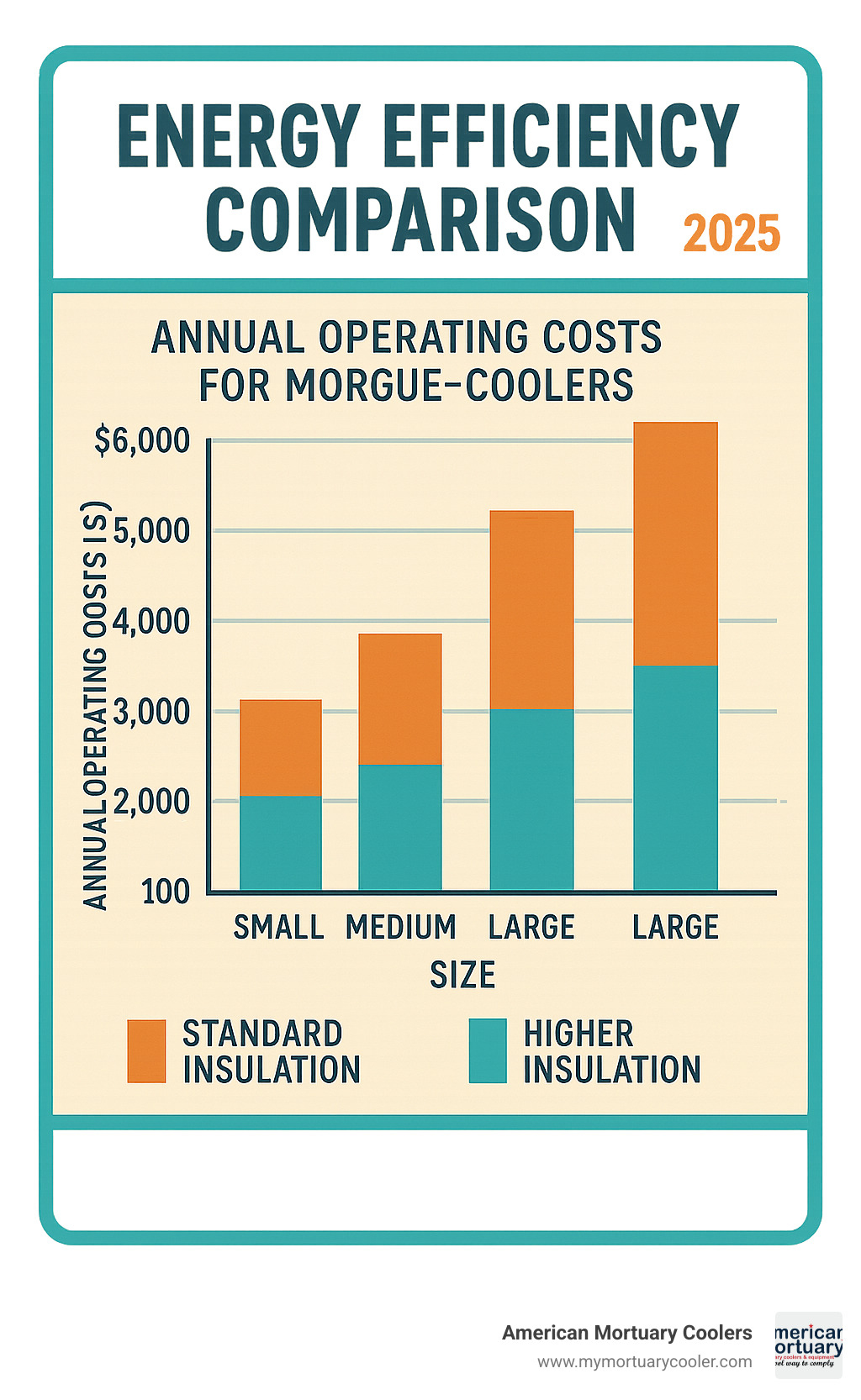
Frequently Asked Questions about Morgue Coolers
How cold should a morgue-cooler be?
The sweet spot for most morgue-cooler units is between 36°F-39°F (2°C-5°C). This temperature range works like a gentle pause button on decomposition—cold enough to slow bacterial growth significantly, but not so cold that it damages delicate tissues.
Think of it this way: at room temperature, you've got maybe 24-48 hours before decomposition becomes noticeable. Drop the temperature to that ideal range, and you've bought yourself weeks of preservation time. That's the difference between scrambling to arrange services and having the breathing room families need to plan properly.
For specialized situations like forensic labs or long-term storage, you'll need negative temperature units running at -10°C to -50°C (-14°F to -58°F). But honestly, most funeral homes never need to go that cold.
The real magic happens with temperature consistency. Modern microprocessor controllers keep things steady within just ±1°C. No wild swings, no hot spots—just reliable preservation day after day.
What size morgue cooler do I need for my facility?
This is probably the most important question you'll answer, and getting it wrong can be expensive. I've seen too many facilities either squeeze by with undersized units or waste money on coolers that could handle a small city.
Start with your average monthly caseload, then add 50% for those unexpected busy periods. If you typically handle 8-10 cases per month, plan for 12-15. Peak seasons, flu outbreaks, or tragic accidents can double your normal volume overnight.
Storage duration matters just as much as volume. If families typically take 7-10 days to arrange services, factor that into your capacity planning. Some facilities turn over quickly; others need more holding capacity for extended arrangements.
Don't forget about space constraints. Measure your available floor space and ceiling height carefully. Walk-in units need dedicated room space but offer maximum storage efficiency. Upright units work better when you're tight on floor space but have good ceiling height.
For most funeral homes, a 2-4 body capacity handles daily operations smoothly. High-volume operations or regional facilities often need walk-in units with 9-25 body capacity. Rural facilities might get by perfectly with a compact 2-body unit, while urban funeral homes often need the flexibility of larger systems.
Can I retrofit an old cooler instead of buying new?
Absolutely—and it can save you thousands if done right. Retrofitting makes particular sense when you have a structurally sound cooler with a failed compressor or outdated controls.
CoolBot technology has been a game-changer for retrofits. You can take an existing walk-in cooler with a dead compressor and retrofit it with specialized controls paired with a standard air conditioner. A complete CoolBot setup for an 8'×12' walk-in runs about $5,000—fraction of the cost of a new commercial system.
The key is getting a professional assessment first. We need to check the structural integrity of existing panels and doors, evaluate insulation condition, and verify electrical compatibility. Sometimes the bones are good but the insulation has degraded, or the electrical system needs updating for current codes.
Cost comparison is crucial. If retrofit costs climb above 60-70% of new equipment prices, you're usually better off starting fresh. Plus, new units come with full warranties and the latest energy-efficient technology.
The biggest consideration is regulatory compliance. Older units might not meet current OSHA, NSF, or EISA standards. Sometimes retrofit costs include bringing everything up to code, which can add significantly to the project budget.
Conclusion
Choosing the right morgue-cooler doesn't have to be overwhelming. Think of it like finding the perfect fit—you need something that matches your daily needs, fits your space, and won't break your budget. Whether you're running a small rural funeral home or managing a busy regional facility, there's a solution that makes sense for your operation.
The beauty of modern morgue-cooler technology lies in its flexibility. A compact 2-body unit might be perfect for your current needs, but modular designs mean you can expand as your business grows. Walk-in systems with cantilever racks serve high-volume operations beautifully, while plug-and-play body boxes offer immediate solutions for facilities with space constraints.
At American Mortuary Coolers, we've spent years understanding the unique challenges funeral professionals face. Based right here in Tennessee, we've helped facilities across Georgia, Illinois, and nationwide find morgue-cooler solutions that actually work for their specific situations. No cookie-cutter approaches—just custom solutions that fit like they were made for you.
What sets us apart is our commitment to the long haul. Our 15-year panel warranty and 5-year mechanical warranty aren't just numbers on paper—they represent our confidence in American-made quality and our dedication to keeping your operation running smoothly. When you're dealing with families during their most difficult moments, equipment reliability isn't just important—it's essential.
We know that every facility has its own personality, constraints, and goals. That's why we take the time to understand your operation before recommending solutions. Whether you need a simple upright unit that plugs into a standard outlet or a sophisticated walk-in system with WiFi monitoring and redundant refrigeration, we'll guide you through the process with straight talk and honest advice.
Ready to find your perfect morgue-cooler match? Let's start a conversation about your specific needs. We'll assess your facility, discuss your budget, and recommend options that make sense for both today and tomorrow. Our nationwide delivery means you'll have professional support from consultation through installation and beyond.
More info about Morgue Coolers
Contact us today for a personalized consultation and quotation. Your families deserve the dignity of proper care, and your staff deserves equipment they can count on.
